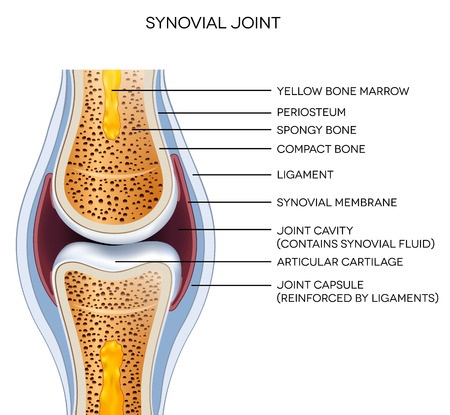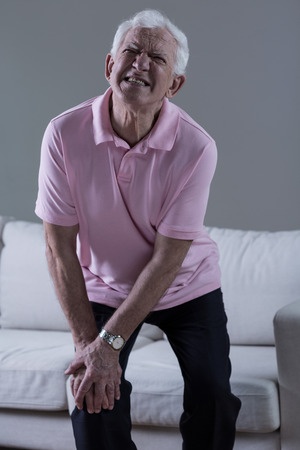Exercise for knee pain

Knee pain can occur at any stage of life, often as a result of overuse whether from intense activity in our younger years or wear and tear as we age. However, these are not the only causes, and according to Arthritis UK over 4 million people in the UK have sought treatment for osteoarthritis of the knee.
Other common causes can be menisci or cartilage damage, bursitis, ligament tears, tendonitis, sprains and strains or gout.
The knee joint is a synovial joint, meaning it has particular internal structures to aid its function (as illustrated below).

As well as a synovial joint, the knee is a hinge joint meaning it can only move in one plane, along one axis with the muscles that interact with it flexing or extending it. This makes the knee joint susceptible to injury from twisting or turning as it is not designed to rotate. It also means that as it can only move in one manner, essentially swinging the lower leg forwards or backwards, the same internal tissues such as the cartilage get used in the same way, time after time making wear and tear common as we age, leading to pain and/or discomfort. It has been reported that 47% of over 50s have endured knee pain, with a third of these consulting with their GP about it (Jinks, et al. 2004).

There’s also the issue of your bodyweight, which the knee joint has to withstand every time you stand up and step when you walk or run, putting strain and stress through the joint. Hence, the heavier you are the greater the stress on the joint, and as noted by the NHS, overweight people are more likely to damage their knees.
What to do about it
Short term
In the first instance, particularly if your knee pain has come on suddenly, such as a strain or sprain from activity, it is widely recommended to apply RICE – Rest, Ice, Compress, Elevate. Rest for a few days giving your knee a break from activity and apply ice 3 or 4 times a day for 15-20 minutes for a few days. It’s good to compress the knee with a bandage or knee strap to keep swelling down and add support to the joint. Elevating your leg will also help reduce the swelling.
Long term
Long term knee pain is often caused from and underlying condition such as being overweight. Therefore, losing weight is the best solution to take the strain off the knee joint.
Strengthening the muscles that interact with the knee joint will also help to reduce many long term causes. The quadriceps; that straighten or extend the knee, and hamstrings; that bend or flex the knee are the primary muscles involved. Strengthening your gluteals (buttocks) and calf muscles will also benefit the knee joint by being able to withstand greater forces each time you walk or run.
How to exercise for knee pain
Trying to be active can help, as long as this doesn’t initiate sharp or unbearable pain. If this is the case, then stop the activity. It’s likely that moving may be uncomfortable which often results in not doing it, but this can be counterproductive as not doing anything will often exacerbate the issue.
Going for gentle walks for 10-15mins, standing while watching the TV and doing light housework are ways to be active that can help you reduce your knee pain. Of course, these activities alone won’t treat the issue, but they will help. Being more active not only requires using muscles, preventing them from weakening, but also contributes to your daily calorie expenditure helping you to lose weight, if you are trying to.
Combing diet and activity with the following exercises will help you get stronger to better cope with some of the stress endured by your knee joint.
Strengthening exercises
There’s different ways to strengthen the muscles supporting your knee joint. A good place to start is by using your own bodyweight and resistance bands. Exercises for knee pain include:
- Sit to stand – one of the best exercises for leg strength
- Leg strengthener – recommended by Arthritis Research UK
- Leg Raise – which you can even do when you’re watching TV
- Step Ups – just walking up and down stairs is a great exercise
For instructions on how to perform each exercise, see our strength improving DVD
Oliver
Hi,
I appreciate your efforts in writing such a detailed post. Thanks for sharing such beautiful information with us.
Many people don’t realize that the improper biomechanics starts from the hip being too tight, pulling on the tendons and muscles of the legs and causing the knees to collapse in or out improperly.
Any physiotherapist or good trainer will tell you increasing mobility of the hips and muscles attached can immediatly reduce strain on knees.
Mobility first, exercises second then everything else good will follow.